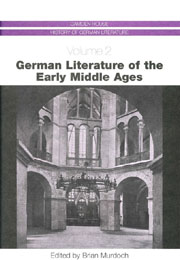Book contents
- Frontmatter
- Contents
- List of Illustrations
- Preface
- List of Abbreviations
- Introduction
- Into German: The Language of the Earliest German Literature
- Charms, Recipes, and Prayers
- Latin Prose: Latin Writing in the Frankish World, 700–1100
- Latin Verse
- Heroic Verse
- Otfrid of Weissenburg
- The Shorter German Verse Texts
- Historical Writing in and after the Old High German Period
- Late Old High German Prose
- Bibliography
- Notes on the Contributors
- Index
Charms, Recipes, and Prayers
Published online by Cambridge University Press: 05 February 2013
- Frontmatter
- Contents
- List of Illustrations
- Preface
- List of Abbreviations
- Introduction
- Into German: The Language of the Earliest German Literature
- Charms, Recipes, and Prayers
- Latin Prose: Latin Writing in the Frankish World, 700–1100
- Latin Verse
- Heroic Verse
- Otfrid of Weissenburg
- The Shorter German Verse Texts
- Historical Writing in and after the Old High German Period
- Late Old High German Prose
- Bibliography
- Notes on the Contributors
- Index
Summary
IT CANNOT BE EMPHASIZED SUFFICIENTLY that all the material that we have in Old High German was written down in the context of the Christian Church. Nevertheless, some German texts, even though committed to writing by monks, contain at least some clues to pre-Christian, pagan writings and religious thought. Of particular interest in this respect are the few glimpses of Germanic religion that have survived in the early German charms. It is understandable, too, that even though all the pieces we have are Christianized, a disproportionate amount of attention has been paid to that aspect of these small texts. By charms (the word derives from the Latin carmen, with the sense here of a solemn or chanted incantation) are meant short texts, the earliest of them oral in origin, in verse or prose, designed in their original form to effect — to conjure, in fact — some sort of cure or change by the power of the word alone, often assisted by the invocation of deities. Thus, one classical Latin charm from Pliny, for removing a fishbone from the throat, requires the charm-worker to lay hands on the sufferer and say Lafana piscator, exi et fac quae te iussit Iuppiter! (Fisherman Lafana, come out and do as Jupiter commands you). Actions can be called for as well, and sometimes otherwise arcane “magic words” (abracadabra is probably the most familiar) are used. Charms often contain the instruction that things are to be said aloud, but magic words (and, later, Christian formulas or names) may also be written down to be used as periapts, as portable charms or amulets, in the sense of the modern good-luck charm.
- Type
- Chapter
- Information
- German Literature of the Early Middle Ages , pp. 57 - 72Publisher: Boydell & BrewerPrint publication year: 2004



